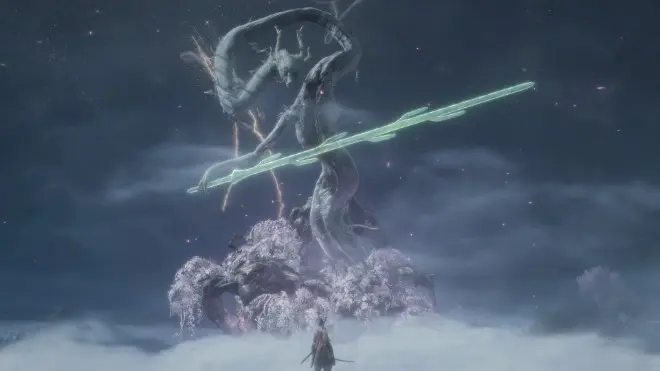For the first ten hours or so, I was pretty iffy on Sekiro: Shadows Die Twice. I had died twenty times on the second mini-boss in the game, and then struggled to find a proper support item to help me defeat it. Hell, even the first boss gave me a ton of difficulty until I started taking my time with my attacks, figuring out the dance I needed to perform with each enemy, and then slashing away.
That’s kind of the beauty of Sekiro though. It demands your patience and precision, and feigns forced aggression. I say this, because Sekiro often makes it seem like attacking and blocking are the best ways to break an enemy’s posture in order to land a powerful deathblow. Often, dodging and picking the right moment of attack is the best way to chip down an enemy’s healthbar, and the more damage they retain, the slower their posture recovers. I learned this the hard way, by hours and hours of deaths. One day, I picked up the controller, and fought a horseback general a little more defensively. Choosing to deflect his attacks and choose the right moment to do a little damage and whittle away his health instead of trying to quickly deal damage to his posture bar.
My eyes were open. It was at this moment, that the rest of my playthrough became much more manageable and understandable. I was going about it the wrong way, treating Sekiro: Shadows Die Twice more like Dark Souls or Bloodborne than its own unique entity. The similarities are there, sure, but Sekiro requires deep precision, and a quick finger to execute properly.
Immediately, the biggest difference between this and FromSoftware’s other titles is the inclusion of a narrative. Players take control of Sekiro, the one-armed wolf to strike down foes. After losing an arm protecting Lord Kuro, Sekiro wakes up near an old sculptor who grants him a prosthetic arm, a useful tool for the journey that provides a wide range of different support attacks. Sekiro’s journey takes him through a handful of unique locations in an attempt to find his master, and sever the ties of immortality raging in Kuro’s divine blood.
It’s nice having a narrative for once, and provides an immediate connection between player and protagonist. Part of the Dark Soul’s charm was reading through text to discover the story and lore of the world, but it didn’t make an emotional connection with players. Here, players know what they are fighting for. Sekiro is an incredibly difficult game still, and having that narrative doesn’t take away from the accomplishment of taking down a large beast after spending hours learning a moveset just to get a few stabs in.
While some games respect player’s time with content, Sekiro’s respect comes from being patient. Learning the right moment to deflect, being patient with attacks, or even learning the right second to jump to avoid a fatal blow. I never felt like the game was being unfair, even when I would rush into a boss room and die within seconds (trust me, that happened more times than I could count.) However, while Sekiro does have a narrative, and a general direction for players to go, there’s never one clear path on how to get there. Often, the one-armed wolf can take to higher areas to get the drop on an enemy, or slink through tall grass and under buildings for a stealth attack. Hell, if one area is giving you too much trouble, head a different direction all together to fight some enemies or earn one of the game’s many collectibles to increase attack or health. There are plenty of options available, especially if you’re having trouble defeating a boss.
There’s a nice variation between the distinct areas in the game as well. Using grapple points to navigate large pillars over an open pit while avoiding enemy gunfire was thrilling. As was exploring the nooks and crannies of a large centrally located temple. The world is a beauty to explore, and while it isn’t the best looking game on the market, the smooth gameplay and vistas make up for it. Additionally, adding a sense of verticality to the world was a smart move. For a shinobi, Sekiro absolutely should be able to navigate vertically, and that extra layer of exploration depth is something I’m now fully expecting from future FromSoftware titles.
Combat is the major thing players are here for though, so let’s jump into that. Sekiro: Shadows Die Twice boils down (mostly) to a few buttons. Jump, dodge, block, attack. These are the moves players should get used to because they’ll use the most. Every enemy has a posture bar that slowly fills up by attacking them or deflecting their attacks. Once that posture bar is full, or their health bar drops to zero, Sekiro can perform a finishing move that puts them down. It seems simple enough, but even one wrong move can lead to death, especially when faced with more than a single enemy. Early on, I was relying too much on plain blocking instead of deflecting, which led to some very early frustration.
The dance between player and enemy while deflecting and attacking is a thing of beauty, especially when compared to kiting enemies in Dark Souls. Things move swiftly in Sekiro, and players are forced to either dig in or back out. While a lot of the basic enemies have simple sword strikes, it’s not long before unblockable attacks are thrown into the mix. Some of these can be deflected or dodged, but defensive maneuvers like the Mikiri counter help provide players some options for an aggressive defense, if timed right. It all circles back to whether or not Sekiro ever felt unfair, but more often than not I mistimed a jump, or ended up dodging past an enemy while trying to peform a Mikiri counter. I’m at the end of my second playthrough now, and some bosses are definitely still more frustrating than others due to a wild moveset, but the level of difficulty feels spot on for what I’m trying to do. The game is hard, and it rewards you for your work.
There are four different endings that players can strive for too, with hidden bosses mixed in depending on the ending players are going for. This adds a ton of replayability to Sekiro: Shadows Die Twice, and I’m already planning my third and fourth playthrough so I get to see everything Sekiro has to offer. Like the other Soulsborne games, each successive new game + adds enemy strength, health, and posture. Defeating bosses allows players to increase their attack power, giving them some extra firepower when going into battle, and these attack boosts continue through further playthroughs.
Despite having a hard time for a while when Sekiro: Shadows Die Twice began, I’m glad I stuck through it. I may like Bloodborne a little more, but it’s boiling down to nitpicking at this point. Sekiro: Shadows Die Twice is easily the best gaming experience I’ve had this year, and probably the best one I’ve had since God of War. If you’re a fan of FromSoftware, this is one you shouldn’t miss, and will reward you greatly for putting the time in to learn the intricacies of its combat.
Sekiro: Shadows Die Twice is available now for Playstation 4, Xbox One, and PC. This review is based on a PS4 copy of the game provided by Activision.








